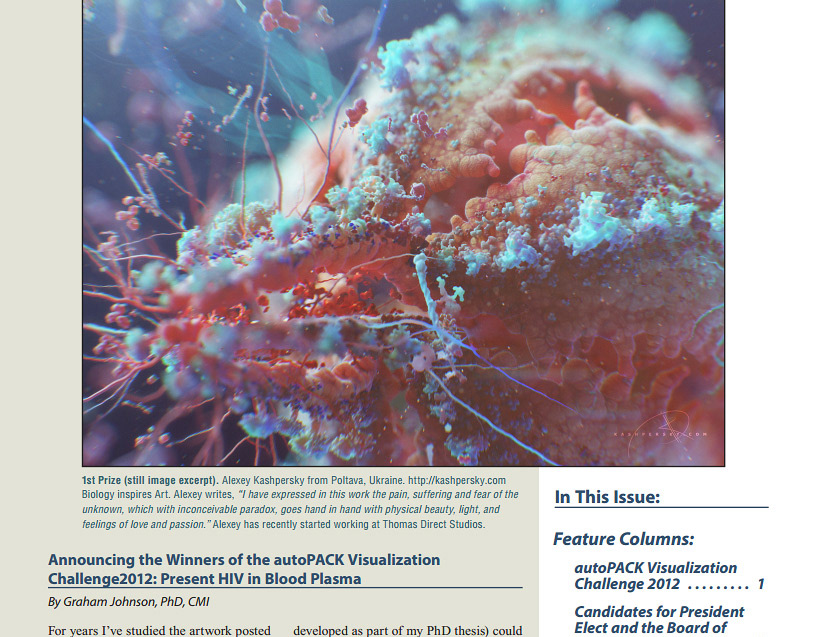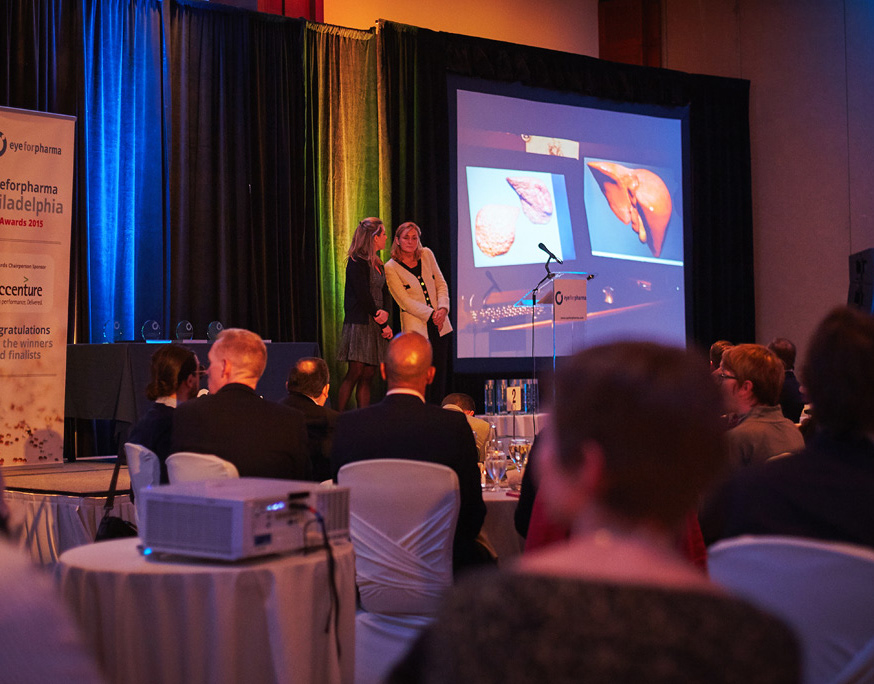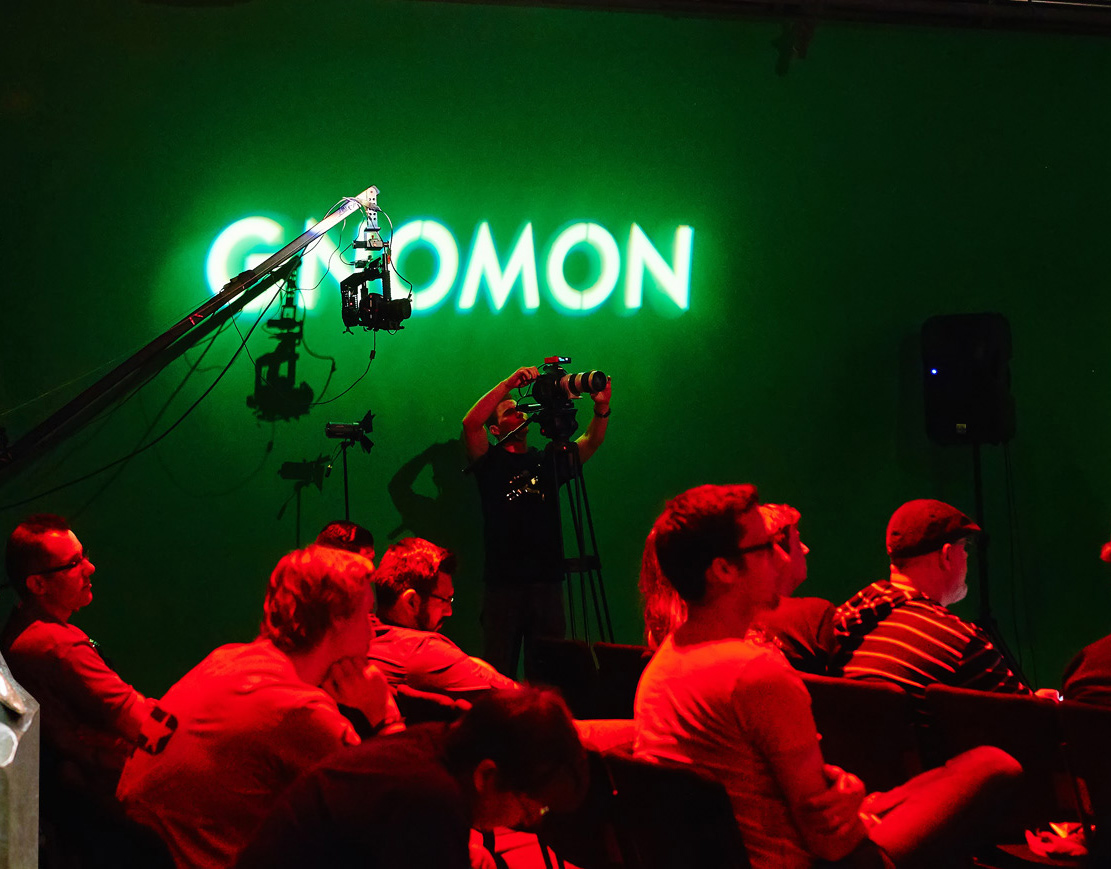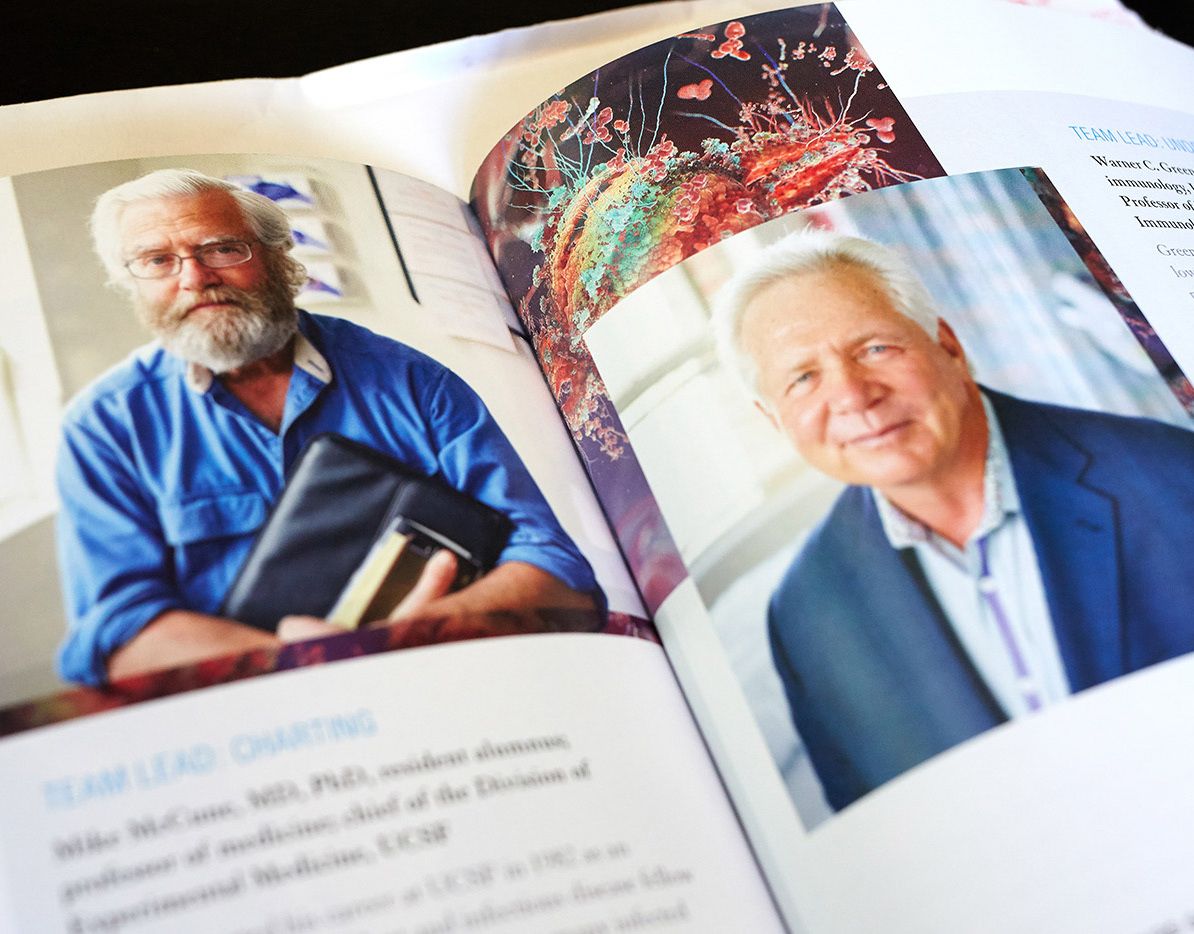Full photoreport from the exhibition (500 photos) is here.
THIS EXHIBITION EXAMINES MICHELANGELO BUONARROTI’S GENIUS AS A DRAFTSMAN AND DESIGNER WITHIN THE WIDEST POSSIBLE SCOPE OF HIS CREATIVITY AS A SCULPTOR, PAINTER, AND ARCHITECT. IN 1568 THE BIOGRAPHER GIORGIO VASARI LAUDED MICHELANGELO’S INCOMPARABLE COMMAND OF DISECNO. AN ITALIAN WORD THAT ENCOMPASSES THE MEANINGS OF BOTH “DRAWING,” IN CONCRETE TERMS, AND “DESIGN: IN THE ABSTRACT SENSE OF THE CREATIVE IDEA. MICHELANGELO’S DISECNO ULTIMATELY EXPLAINED HIS MASTERY AND VERSATILITY IN THE THREE MAJOR ARTS—SCULPTURE, PAINTING, AND ARCHITECTURE—TO HIS CONTEMPORARIES. THEY REVERED WORK “BY HIS HAND,” AND THE NOTION OF AUTHENTICITY AS UNDERSTOOD IN HIS TIME IS EXPLORED HERE IN A VARIETY OF WAYS.
BORN IN CAPRESE (SOUTHEAST OF FLORENCE) ON MARCH 6, 1475, MICHELANGELO WAS FIRST PRAISED AS IL DIVINO (THE DIVINE ONE) AT THE AGE OF FORTY-ONE, BY THE ITALIAN POET LUDOVICO ARIOSTO. THE ACCOLADE ACCOMPANIED INVENTION OF THE ARTIST’S NAME FOR THE REST OF HIS LIFE, AS HE WAS BEFRIENDED BY NOBLES AND HONORED BY POPES AND MONARCHS. HE DIED ON FEBRUARY 18,1564, A WEALTHY, FAMOUS, AND UNUSUAU-Y LONG-LIVED MAN, ALREADY THE SUBJECT OF A NUMBER OF BIOGRAPHIES. ALTHOUGH HE CONSIDERED HIMSELF FOREMOST A SCULPTOR, HE WAS WIDELY RECOGNIZED AS IL DIVIN’DISEGNATORE, “THE DIVINE DRAFTSMAN AND DESIGNER.”
BORN IN CAPRESE (SOUTHEAST OF FLORENCE) ON MARCH 6, 1475, MICHELANGELO WAS FIRST PRAISED AS IL DIVINO (THE DIVINE ONE) AT THE AGE OF FORTY-ONE, BY THE ITALIAN POET LUDOVICO ARIOSTO. THE ACCOLADE ACCOMPANIED INVENTION OF THE ARTIST’S NAME FOR THE REST OF HIS LIFE, AS HE WAS BEFRIENDED BY NOBLES AND HONORED BY POPES AND MONARCHS. HE DIED ON FEBRUARY 18,1564, A WEALTHY, FAMOUS, AND UNUSUAU-Y LONG-LIVED MAN, ALREADY THE SUBJECT OF A NUMBER OF BIOGRAPHIES. ALTHOUGH HE CONSIDERED HIMSELF FOREMOST A SCULPTOR, HE WAS WIDELY RECOGNIZED AS IL DIVIN’DISEGNATORE, “THE DIVINE DRAFTSMAN AND DESIGNER.”
THE EXHIBITION PRESENTS MORE THAN 200 WORKS FROM 48 PUBLIC AND PRIVATE COLLECTIONS IN EUROPE AND THE UNITED STATES. THE 133 DRAWINGS BY MICHELANGELO REUNITED FERE ARE INFREQUENTLY ON PUBLIC DISPLAY BECAUSE OF THEIR FRAGILITY AND RARITY. THE SELECTION FEATURES DRAWINGS IN A VARIETY OF IVEDIA AND OF A GREAT DIVERSITY OF TYPES —SMALL AND LARGE IN SCALE, FAMOUS AND LITTLE KNOWN.THE EXHIBITION ALSO INCLUDES HIS EARLIEST SURVIVING PAINTING, THREE MARBLE SCULPTURES, AND AN ARCHITECTURAL MODEL IN WOOD, AS WEB AS AN ARRAY OF COMPLEMENTARY WORKS BY MICHELANGELO’S TEACH:RS, ASSOCIATES, AND PUPILS, AND BY OTHER ARTISTS, INCLUDING ANCIENT SCULPTORS, WHO INSPIRED HIM. TOGETHER, THESE ARTWORKS CHART THE INVENTIVE POWERS AND COMPLEXITY OF IL DIVIN’ DISEGNATORE.
THE EDUCATION OF THE YOUNG ARTIST
While Michelangelo and his biographers downplayed the significance of his early training in the Ghirlandaio workshop in Florence (1487-90/91), research aided by scientific imaging techniques continues to uncover important connections to the creative processes of his late fifteenth-century predecessors. The Florentine workshops of the Ghirlandaio family, Andrea del Verrocchio, and the brothers Antonio and Piero del Pollaiuolo were places of stimulating collaboration (and rivalry), professional networking, shared knowledge, efficient delegation of labor, high productivity, and impressive technical development.
This section presents works by Michelangelo’s teacher Domenico Ghirlandaio, a virtuosic draftsman in metalpoint, black chalk, and pen and ink, and by some of Michelangelo’s contemporaries, such as Francesco Granacci—a lifelong friend who studied with him in the Ghirlandaio workshop. There, Michelangelo learned various techniques of drawing and of painting in tempera and fresco, as well as general procedures for designing compositions. Also on view is Michelangelo’s fabled first painting, the Torment of Saint Anthony.
Although Vasari emphasized Michelangelo’s break with the immediate past, the biographer celebrated the young artist’s study of works by Giotto, Masaccio, and Donatello—the great masters who represented the earlier, heroic era of Italian art Michelangelo’s earliest surviving drawings, seen here, from the mid- to late 1490s, are inspired copies after these artists and the ancients.
While Michelangelo and his biographers downplayed the significance of his early training in the Ghirlandaio workshop in Florence (1487-90/91), research aided by scientific imaging techniques continues to uncover important connections to the creative processes of his late fifteenth-century predecessors. The Florentine workshops of the Ghirlandaio family, Andrea del Verrocchio, and the brothers Antonio and Piero del Pollaiuolo were places of stimulating collaboration (and rivalry), professional networking, shared knowledge, efficient delegation of labor, high productivity, and impressive technical development.
This section presents works by Michelangelo’s teacher Domenico Ghirlandaio, a virtuosic draftsman in metalpoint, black chalk, and pen and ink, and by some of Michelangelo’s contemporaries, such as Francesco Granacci—a lifelong friend who studied with him in the Ghirlandaio workshop. There, Michelangelo learned various techniques of drawing and of painting in tempera and fresco, as well as general procedures for designing compositions. Also on view is Michelangelo’s fabled first painting, the Torment of Saint Anthony.
Although Vasari emphasized Michelangelo’s break with the immediate past, the biographer celebrated the young artist’s study of works by Giotto, Masaccio, and Donatello—the great masters who represented the earlier, heroic era of Italian art Michelangelo’s earliest surviving drawings, seen here, from the mid- to late 1490s, are inspired copies after these artists and the ancients.
THE YOUNG SCULPTOR-DESIGNER AND HIS SOURCES
Michelangelo considered himself first and foremost a sculptor in marble. His emphasis on the three-dimensional form in drawings emerged alongside his practice as a marble sculptor, informed by his close study of classical sculpture and the work of Donatello. Contemporary biographers agree that Michelangelo’s friend Francesco Granacci introduced him to Lorenzo de’ Medici’s Garden of San Marco (probably around 1490-91), which featured a lauded collection of antique and Renaissance sculptures curated by Bertoldo di Giovanni, a student of Donatello’s.
Michelangelo’s marble Young Archer, carved in the late 1490s, is the focal point of this gallery. His precocious understanding of the figure is wholly personal and innovative, yet the young artist has not fully unified the different parts or synthesized the lessons learned from his predecessors. Works by classical sculptors and Bertoldo here illuminate certain aspects of Michelangelo’s approach to the figure. The tactile surface treatment of the boy’s torso and limbs, evocative of living flesh, is an effect probably learned from Roman and Hellenistic sculptures like the nearby Eros Sleeping. The elegant spiral pose of Michelangelo’s archer may have come to the artist as he studied bronze statuettes by Bertoldo and ancient sculptors.
Michelangelo considered himself first and foremost a sculptor in marble. His emphasis on the three-dimensional form in drawings emerged alongside his practice as a marble sculptor, informed by his close study of classical sculpture and the work of Donatello. Contemporary biographers agree that Michelangelo’s friend Francesco Granacci introduced him to Lorenzo de’ Medici’s Garden of San Marco (probably around 1490-91), which featured a lauded collection of antique and Renaissance sculptures curated by Bertoldo di Giovanni, a student of Donatello’s.
Michelangelo’s marble Young Archer, carved in the late 1490s, is the focal point of this gallery. His precocious understanding of the figure is wholly personal and innovative, yet the young artist has not fully unified the different parts or synthesized the lessons learned from his predecessors. Works by classical sculptors and Bertoldo here illuminate certain aspects of Michelangelo’s approach to the figure. The tactile surface treatment of the boy’s torso and limbs, evocative of living flesh, is an effect probably learned from Roman and Hellenistic sculptures like the nearby Eros Sleeping. The elegant spiral pose of Michelangelo’s archer may have come to the artist as he studied bronze statuettes by Bertoldo and ancient sculptors.
THE TOMB OF POPE JULIUS II
Two monumental projects that exemplify Michelangelo’s energy, ambition, and courage were commissioned by Pope Julius II: the Sistine Chapel ceiling frescoes and the pope’s marble tomb. Michelangelo’s forty-year ordeal of completing the tomb ended in February 1545, when the present, scaled-down structure was unveiled in Rome (far from the papal majesty of Saint Peter’s Basilica, the intended site).
Michelangelo labored most intensely on the design drawings and figure studies for the Julius monument between 1505 and 1520-25. The works gathered here served a variety of functions. Intended for the eyes of the patron, the demonstration drawing, or modello, of Michelangelo’s early concept for the tomb is drawn in a clear and careful manner, with all details complete. In a quick sketch for a seated prophet, done for his own creative purposes, he improvised more freely. His magnificent life study for a slave is based on a muscular model (probably a workshop assistant).
Although Michelangelo’s contracts forbade him from undertaking other projects while carving the tomb, he accepted a commission for the marble Christ the Redeemer for the church of Santa Maria sopra Minerva in Rome in 1514. The only confirmed sheet of studies for this sculpture is on view nearby.
Two monumental projects that exemplify Michelangelo’s energy, ambition, and courage were commissioned by Pope Julius II: the Sistine Chapel ceiling frescoes and the pope’s marble tomb. Michelangelo’s forty-year ordeal of completing the tomb ended in February 1545, when the present, scaled-down structure was unveiled in Rome (far from the papal majesty of Saint Peter’s Basilica, the intended site).
Michelangelo labored most intensely on the design drawings and figure studies for the Julius monument between 1505 and 1520-25. The works gathered here served a variety of functions. Intended for the eyes of the patron, the demonstration drawing, or modello, of Michelangelo’s early concept for the tomb is drawn in a clear and careful manner, with all details complete. In a quick sketch for a seated prophet, done for his own creative purposes, he improvised more freely. His magnificent life study for a slave is based on a muscular model (probably a workshop assistant).
Although Michelangelo’s contracts forbade him from undertaking other projects while carving the tomb, he accepted a commission for the marble Christ the Redeemer for the church of Santa Maria sopra Minerva in Rome in 1514. The only confirmed sheet of studies for this sculpture is on view nearby.
THE SCULPTOR-ARCHITECT AT SAN LORENZO
Michelangelo was contracted to work exclusively for two Medici popes for about two decades: Leo X, elected as pope in 1513, and his cousin, the future Clement VII (elected in 1523). They engaged him as sculptor-architect for four ambitious projects (among others) related to the Basilica of San Lorenzo, the Medici family’s parish church and their traditional burial site in Florence. Michelangelo first created designs for a grandiose facade, which was never executed. In 1519 he began building the New Sacristy to house the Medici family tombs; he carved the sculptures for two tombs, while a large team of assistants executed much of the interior architectural sculpture. Almost concurrently, he designed the Laurentian Library, with its magnificent vestibule, adjacent to the two cloisters of the church. The sacristy and library remained unfinished upon his permanent departure from Florence in 1534.
As seen in this gallery, Michelangelo produced a wide variety of drawing types for his projects at San Lorenzo, including sketches, figure studies, and demonstration drawings (modelli) for the patrons.
Michelangelo was contracted to work exclusively for two Medici popes for about two decades: Leo X, elected as pope in 1513, and his cousin, the future Clement VII (elected in 1523). They engaged him as sculptor-architect for four ambitious projects (among others) related to the Basilica of San Lorenzo, the Medici family’s parish church and their traditional burial site in Florence. Michelangelo first created designs for a grandiose facade, which was never executed. In 1519 he began building the New Sacristy to house the Medici family tombs; he carved the sculptures for two tombs, while a large team of assistants executed much of the interior architectural sculpture. Almost concurrently, he designed the Laurentian Library, with its magnificent vestibule, adjacent to the two cloisters of the church. The sacristy and library remained unfinished upon his permanent departure from Florence in 1534.
As seen in this gallery, Michelangelo produced a wide variety of drawing types for his projects at San Lorenzo, including sketches, figure studies, and demonstration drawings (modelli) for the patrons.
DIVINE HEADS AND PORTRAITURE
Michelangelo’s love for the handsome, aristocratic young men he befriended was an open secret among his contemporaries. He produced beautifully finished drawings (disegni finiti) of bust-length figures for intimate friends, which Giorgio Vasari called teste divine, or “divine headsin his 1568 biography. Apart from the drawing technique, the most striking aspect of these representations is the highly decorative detail on the figures’ headdresses and costumes. Though they are largely the artist’s invention, these fantastical passages were inspired in part by antique gems and paintings.
The “divine heads” provide a contrast to Michelangelo’s sole surviving large portrait drawing. It depicts a young nobleman, Andrea Quaratesi, with a remarkable psychological intensity. According to Vasari, Michelangelo “abhorred making a resemblance true to life, unless the subject was of extraordinary beauty.”
Michelangelo’s love for the handsome, aristocratic young men he befriended was an open secret among his contemporaries. He produced beautifully finished drawings (disegni finiti) of bust-length figures for intimate friends, which Giorgio Vasari called teste divine, or “divine headsin his 1568 biography. Apart from the drawing technique, the most striking aspect of these representations is the highly decorative detail on the figures’ headdresses and costumes. Though they are largely the artist’s invention, these fantastical passages were inspired in part by antique gems and paintings.
The “divine heads” provide a contrast to Michelangelo’s sole surviving large portrait drawing. It depicts a young nobleman, Andrea Quaratesi, with a remarkable psychological intensity. According to Vasari, Michelangelo “abhorred making a resemblance true to life, unless the subject was of extraordinary beauty.”
THE TEACHER OF DRAWING
Michelangelo’s large corpus of surviving drawings is full of evidence of how he taught draftsmanship. He often provided models (eyes, heads, skulls, legs) that his pupils then repeated on the same paper. Unlike the students of Leonardo and Raphael, however, his pupils did not go on to have noteworthy independent careers. The artist’s correspondence and Vasari’s biography record the names of various proteges, some of whom must have received drawing lessons from the master, especially between 1510 and 1530. Broadly speaking, Michelangelo’s pupils were of two kinds: garzoni (assistants) he employed as stone carvers, servants, or workshop helpers; and gentiluomini amici (aristocratic male friends).
Michelangelo’s large corpus of surviving drawings is full of evidence of how he taught draftsmanship. He often provided models (eyes, heads, skulls, legs) that his pupils then repeated on the same paper. Unlike the students of Leonardo and Raphael, however, his pupils did not go on to have noteworthy independent careers. The artist’s correspondence and Vasari’s biography record the names of various proteges, some of whom must have received drawing lessons from the master, especially between 1510 and 1530. Broadly speaking, Michelangelo’s pupils were of two kinds: garzoni (assistants) he employed as stone carvers, servants, or workshop helpers; and gentiluomini amici (aristocratic male friends).
THE SISTINE CEILING
Above is a photographic reproduction, at one-quarter scale, of the Sistine Chapel ceiling in the Vatican Palace, which Michelangelo painted in the difficult medium of fresco between 1508 and 1512. Both of his commissions from Pope Julius II, the Sistine ceiling frescoes and the pontiff’s marble tomb, rely on a similar concept of figures populating an architectural framework. Conceiving the design for the ceiling’s monumental surface area, about 1,754 square feet, would have demanded a herculean effort. The works in this gallery are a sampling of the precious few records of this campaign: Michelangelo’s two surviving sheets of sketches for the ceiling’s overall program, which reveal his gradual thought process as he filled the large vault with figures, and his original figure studies in black or red chalk, drawn from life and from models in clay or wax.
In the final frescoes, as seen above, Michelangelo designed an illusionistic framework simulating white marble that contains, along the central spine of the vault, rectangular narrative scenes from the Book of Genesis. Around the perimeter are Prophets alternating with Sibyls (female prophets). Pairs of seated Ignudi (athletic nude youths) flank fictively painted bronze medallions depicting historical events from the Book of Maccabees. The four corners represent episodes in the deliverance of the Jewish people from mortal dangers. In the lower realms are the Ancestors of Christ in the order given by the Gospel of Matthew.
Above is a photographic reproduction, at one-quarter scale, of the Sistine Chapel ceiling in the Vatican Palace, which Michelangelo painted in the difficult medium of fresco between 1508 and 1512. Both of his commissions from Pope Julius II, the Sistine ceiling frescoes and the pontiff’s marble tomb, rely on a similar concept of figures populating an architectural framework. Conceiving the design for the ceiling’s monumental surface area, about 1,754 square feet, would have demanded a herculean effort. The works in this gallery are a sampling of the precious few records of this campaign: Michelangelo’s two surviving sheets of sketches for the ceiling’s overall program, which reveal his gradual thought process as he filled the large vault with figures, and his original figure studies in black or red chalk, drawn from life and from models in clay or wax.
In the final frescoes, as seen above, Michelangelo designed an illusionistic framework simulating white marble that contains, along the central spine of the vault, rectangular narrative scenes from the Book of Genesis. Around the perimeter are Prophets alternating with Sibyls (female prophets). Pairs of seated Ignudi (athletic nude youths) flank fictively painted bronze medallions depicting historical events from the Book of Maccabees. The four corners represent episodes in the deliverance of the Jewish people from mortal dangers. In the lower realms are the Ancestors of Christ in the order given by the Gospel of Matthew.
BRUTUS AND THE SCULPTED BUST
A work of tremendous psychological presence, Michelangelo’s marble Brutus displayed in the center of this space, reintroduced into the tradition of Italian bust sculpture a sobriety of style-described as “pure without ornament” (puro senza ornato)—that had not been seen since Donatello. Michelangelo sought inspiration in ancient Roman portraiture, specifically the marble Caracalla, also on view here. According to a guidebook of 1556, it was owned by a collector living on the same street as the artist. In contrast to the Brutus, the bust of Julius Caesar by Michelangelo’s sometime associate Andrea Ferrucci exemplifies the delicately ornate, all’antica (in the manner of the ancients) style of Florentine sculpture fashionable in the late fifteenth and early sixteenth centuries.
The comparison of these three marble busts—a rare opportunity—attests to Michelangelo’s powers of invention in transforming the art of the past to forge a new, profoundly personal style.
A work of tremendous psychological presence, Michelangelo’s marble Brutus displayed in the center of this space, reintroduced into the tradition of Italian bust sculpture a sobriety of style-described as “pure without ornament” (puro senza ornato)—that had not been seen since Donatello. Michelangelo sought inspiration in ancient Roman portraiture, specifically the marble Caracalla, also on view here. According to a guidebook of 1556, it was owned by a collector living on the same street as the artist. In contrast to the Brutus, the bust of Julius Caesar by Michelangelo’s sometime associate Andrea Ferrucci exemplifies the delicately ornate, all’antica (in the manner of the ancients) style of Florentine sculpture fashionable in the late fifteenth and early sixteenth centuries.
The comparison of these three marble busts—a rare opportunity—attests to Michelangelo’s powers of invention in transforming the art of the past to forge a new, profoundly personal style.
MONUMENTAL ART AND NON FINITO
The works by Michelangelo in this gallery communicate a sense of the monumentality of his art He worked in a complex, highly charged political climate, with variable allegiances and turbulent shifts in leadership. After 1528 his friends and private patrons included anti-Medici Florentines in political exile in Rome; the Apollo-David, Brutus, and Venus Kissed by Cupid were all produced for members of this group.
The Apollo-David and bust of Brutus reveal Michelangelo’s working process in marble with a fascinating immediacy. He carves away to gradually liberate the forms from the inchoate stone block, echoing his famous sonnet: “Not even the best of artists has any conception / that a single marble block does not contain / within its excess, and that is only attained / by the hand that obeys the intellect.” In their incomplete state, the sculptures suggest the quality of non finito, or “lack of finish,” so admired in his work.
The works by Michelangelo in this gallery communicate a sense of the monumentality of his art He worked in a complex, highly charged political climate, with variable allegiances and turbulent shifts in leadership. After 1528 his friends and private patrons included anti-Medici Florentines in political exile in Rome; the Apollo-David, Brutus, and Venus Kissed by Cupid were all produced for members of this group.
The Apollo-David and bust of Brutus reveal Michelangelo’s working process in marble with a fascinating immediacy. He carves away to gradually liberate the forms from the inchoate stone block, echoing his famous sonnet: “Not even the best of artists has any conception / that a single marble block does not contain / within its excess, and that is only attained / by the hand that obeys the intellect.” In their incomplete state, the sculptures suggest the quality of non finito, or “lack of finish,” so admired in his work.
GIFT DRAWINGS FORTOMMASO DE’ CAVALIERI AND OTHER FRIENDS
In 1532, at age fifty-seven, Michelangelo met the young Roman nobleman Tommaso de’ Cavalieri, and they became lifelong friends. Tommaso, who would eventually be one of the great collectors of antiquities and drawings, impressed the artist with his classical learning and appreciation for culture. Utterly smitten, Michelangelo expressed his intense feelings for Tommaso by giving him beautifully finished drawings and passionate poetry.
All on display in this room, the surviving drawings made as gifts for Tommaso are the jewels of Michelangelo’s draftsmanship. The subjects are inspired by classical mythology. Although the drawings were private gifts, the compositions soon became famous and were widely reproduced in prints, paintings, drawings, gems, and relief sculptures by a variety of artists. Michelangelo created refined drawings as gifts for other friends and patrons as well.
In 1532, at age fifty-seven, Michelangelo met the young Roman nobleman Tommaso de’ Cavalieri, and they became lifelong friends. Tommaso, who would eventually be one of the great collectors of antiquities and drawings, impressed the artist with his classical learning and appreciation for culture. Utterly smitten, Michelangelo expressed his intense feelings for Tommaso by giving him beautifully finished drawings and passionate poetry.
All on display in this room, the surviving drawings made as gifts for Tommaso are the jewels of Michelangelo’s draftsmanship. The subjects are inspired by classical mythology. Although the drawings were private gifts, the compositions soon became famous and were widely reproduced in prints, paintings, drawings, gems, and relief sculptures by a variety of artists. Michelangelo created refined drawings as gifts for other friends and patrons as well.
ART AND PERSONAL SPIRITUALITY
In 1534 Michelangelo moved permanently to Rome, where he spent the last thirty years of his life. His poetic impulse and deepening spirituality during this time nurtured his artistic vision. His most prolific writing of poetry, between 1536 and 1546, coincided with his friendship with Vittoria Colonna, marchesa of Pescara and the only significant woman poet of her time. Highly cultured and of exalted social standing, she exhibited intellect, power, and fervent spirituality. Their poetry reveals a shared emphasis on a personal, unmediated relationship with God. Michelangelo expressed his deep, though not romantic, love for Vittoria through gifts of poetry and drawings. The private drawings soon became famous enough that their designs were replicated in a variety of media. In 1540 or 1541, she presented him with the rare manuscript of her spiritual poetry on view here.
Also in this gallery is the enormous, exceedingly rare cartoon (full-scale drawing) that Michelangelo prepared for the Crucifixion of Saint Peter fresco in the Pauline Chapel (Vatican Palace), finished in 1550.
In 1534 Michelangelo moved permanently to Rome, where he spent the last thirty years of his life. His poetic impulse and deepening spirituality during this time nurtured his artistic vision. His most prolific writing of poetry, between 1536 and 1546, coincided with his friendship with Vittoria Colonna, marchesa of Pescara and the only significant woman poet of her time. Highly cultured and of exalted social standing, she exhibited intellect, power, and fervent spirituality. Their poetry reveals a shared emphasis on a personal, unmediated relationship with God. Michelangelo expressed his deep, though not romantic, love for Vittoria through gifts of poetry and drawings. The private drawings soon became famous enough that their designs were replicated in a variety of media. In 1540 or 1541, she presented him with the rare manuscript of her spiritual poetry on view here.
Also in this gallery is the enormous, exceedingly rare cartoon (full-scale drawing) that Michelangelo prepared for the Crucifixion of Saint Peter fresco in the Pauline Chapel (Vatican Palace), finished in 1550.
COLLABORATION: MARCEUO VENUSTI
This section frames the artistic relationship between Michelangelo and Marcello Venusti as one of professional friendship and collaboration, and probably a formal arrangement. A 1642 biography of Venusti confirms that he “befriended and took on service for Michelagnolo Buonarroti, the Florentine, who gave him many works to produce from his drawings.” Too busy and uninterested in painting, Michelangelo relied on Venusti to produce small religious pictures based on his designs. As one of his closest proteges from 1546 until the master’s death in 1564, Venusti replicated Michelangelo’s religious compositions slavishly, and in great numbers; he subsequently gained a level of artistic autonomy and financial well-being. Michelangelo was godfather to Venusti’s son, who was named after the master.
This section frames the artistic relationship between Michelangelo and Marcello Venusti as one of professional friendship and collaboration, and probably a formal arrangement. A 1642 biography of Venusti confirms that he “befriended and took on service for Michelagnolo Buonarroti, the Florentine, who gave him many works to produce from his drawings.” Too busy and uninterested in painting, Michelangelo relied on Venusti to produce small religious pictures based on his designs. As one of his closest proteges from 1546 until the master’s death in 1564, Venusti replicated Michelangelo’s religious compositions slavishly, and in great numbers; he subsequently gained a level of artistic autonomy and financial well-being. Michelangelo was godfather to Venusti’s son, who was named after the master.
THE NUDE BODY AND THE LAST JUDGEMENT
In 1533 Pope Clement VII commissioned Michelangelo to return to the Sistine Chapel, the most prominent ceremonial site for the papal court to paint an enormous Last Judgment fresco on the wall behind the altar. The project continued during the papacy of Paul III, Michelangelo’s greatest patron in his later years and one who gave him immense artistic freedom. He produced drawings for the fresco over a protracted period, beginning in 1533 with the first compositional sketches and life drawings and continuing with the revision of partial cartoons and other designs until about 1540.
Controversy erupted soon after the public unveiling of the Last Judgment in December 1541, focused primarily on the nudity of the figures. The spread of the Protestant Reformation in northern Europe had elicited a strong conservative reaction from the Roman Catholic Church, culminating in the Council of Trent (1545-63) and a new era of censures. As even the sharpest critics conceded, however, the Last Judgment is a celebration of all that art can accomplish in depicting the human body. Although denounced as blasphemous, Michelangelo’s emphasis on the beauty of the physical form alludes in a personal, if unorthodox, way to the religious doctrine of the Resurrection of the Dead.
In 1533 Pope Clement VII commissioned Michelangelo to return to the Sistine Chapel, the most prominent ceremonial site for the papal court to paint an enormous Last Judgment fresco on the wall behind the altar. The project continued during the papacy of Paul III, Michelangelo’s greatest patron in his later years and one who gave him immense artistic freedom. He produced drawings for the fresco over a protracted period, beginning in 1533 with the first compositional sketches and life drawings and continuing with the revision of partial cartoons and other designs until about 1540.
Controversy erupted soon after the public unveiling of the Last Judgment in December 1541, focused primarily on the nudity of the figures. The spread of the Protestant Reformation in northern Europe had elicited a strong conservative reaction from the Roman Catholic Church, culminating in the Council of Trent (1545-63) and a new era of censures. As even the sharpest critics conceded, however, the Last Judgment is a celebration of all that art can accomplish in depicting the human body. Although denounced as blasphemous, Michelangelo’s emphasis on the beauty of the physical form alludes in a personal, if unorthodox, way to the religious doctrine of the Resurrection of the Dead.
COLLABORATION: DANIELE DAVOLTERRA
In the late 1530s and the 1540s Michelangelo found a devoted friend in the experienced sculptor-painter Daniele da Volterra. Michelangelo turned to the versatile artist, thirty-four years his junior, to produce monumental paintings and sculptures that were commissioned by important patrons, but that the aged master declined to execute himself. Posterity has often been unkind to Daniele for having painted discreet coverings on the nudes in the Last Judgment in 1565, on the orders of Pope Paul IV, a task that earned him the nickname of braghettone, or “breeches maker.”
This section focuses on three of Daniele’s projects for which Michelangelo produced sketches—two paintings and a monumental equestrian statue- that illuminate the method of collaboration between master and assistant. It is plausible that Michelangelo was approached to create the compositions but, owing to overwork or lack of interest, did only the initial sketches (to satisfy a patron’s demand for work by his hand) and then delegated the detailed drawings and actual painting or sculpture to Daniele.
In the late 1530s and the 1540s Michelangelo found a devoted friend in the experienced sculptor-painter Daniele da Volterra. Michelangelo turned to the versatile artist, thirty-four years his junior, to produce monumental paintings and sculptures that were commissioned by important patrons, but that the aged master declined to execute himself. Posterity has often been unkind to Daniele for having painted discreet coverings on the nudes in the Last Judgment in 1565, on the orders of Pope Paul IV, a task that earned him the nickname of braghettone, or “breeches maker.”
This section focuses on three of Daniele’s projects for which Michelangelo produced sketches—two paintings and a monumental equestrian statue- that illuminate the method of collaboration between master and assistant. It is plausible that Michelangelo was approached to create the compositions but, owing to overwork or lack of interest, did only the initial sketches (to satisfy a patron’s demand for work by his hand) and then delegated the detailed drawings and actual painting or sculpture to Daniele.
THE SCULPTOR-ARCHITECT IN THE ETERNAL CITY
1534-64
Beautifully elaborated, often with ideas layered one over the other, Michelangelo’s late architectural drawings were like nothing that had been seen before.
At the core of his approach to architecture was his sculptor’s sensibility that form should unify and command space. The drawings appear powerfully three-dimensional and luminous. As complements to his drawings, he relied on models such as the rare wood example on view here.
Little of Michelangelo’s planned architectural work in Rome, where he settled permanently in 1534, was constructed during his lifetime, although his ideas and designs ultimately transformed the Eternal City. His original drawings for monumental architecture and urban redesign do not survive, but his intentions are recorded in a series of prints published around the time of his death. His projects in Rome include, among others, the complete redesign of the Capitoline Hill, or Campidoglio; revisions and a redesign of Antonio da Sangallo the Younger’s Palazzo Farnese; plans for the church of San Giovanni dei Fiorentini; and the construction of the Porta Pia. As chief architect of the new Saint Peter’s Basilica for seventeen years, he left an indelible mark, evident today mainly in the dome and the southwest transept.
1534-64
Beautifully elaborated, often with ideas layered one over the other, Michelangelo’s late architectural drawings were like nothing that had been seen before.
At the core of his approach to architecture was his sculptor’s sensibility that form should unify and command space. The drawings appear powerfully three-dimensional and luminous. As complements to his drawings, he relied on models such as the rare wood example on view here.
Little of Michelangelo’s planned architectural work in Rome, where he settled permanently in 1534, was constructed during his lifetime, although his ideas and designs ultimately transformed the Eternal City. His original drawings for monumental architecture and urban redesign do not survive, but his intentions are recorded in a series of prints published around the time of his death. His projects in Rome include, among others, the complete redesign of the Capitoline Hill, or Campidoglio; revisions and a redesign of Antonio da Sangallo the Younger’s Palazzo Farnese; plans for the church of San Giovanni dei Fiorentini; and the construction of the Porta Pia. As chief architect of the new Saint Peter’s Basilica for seventeen years, he left an indelible mark, evident today mainly in the dome and the southwest transept.

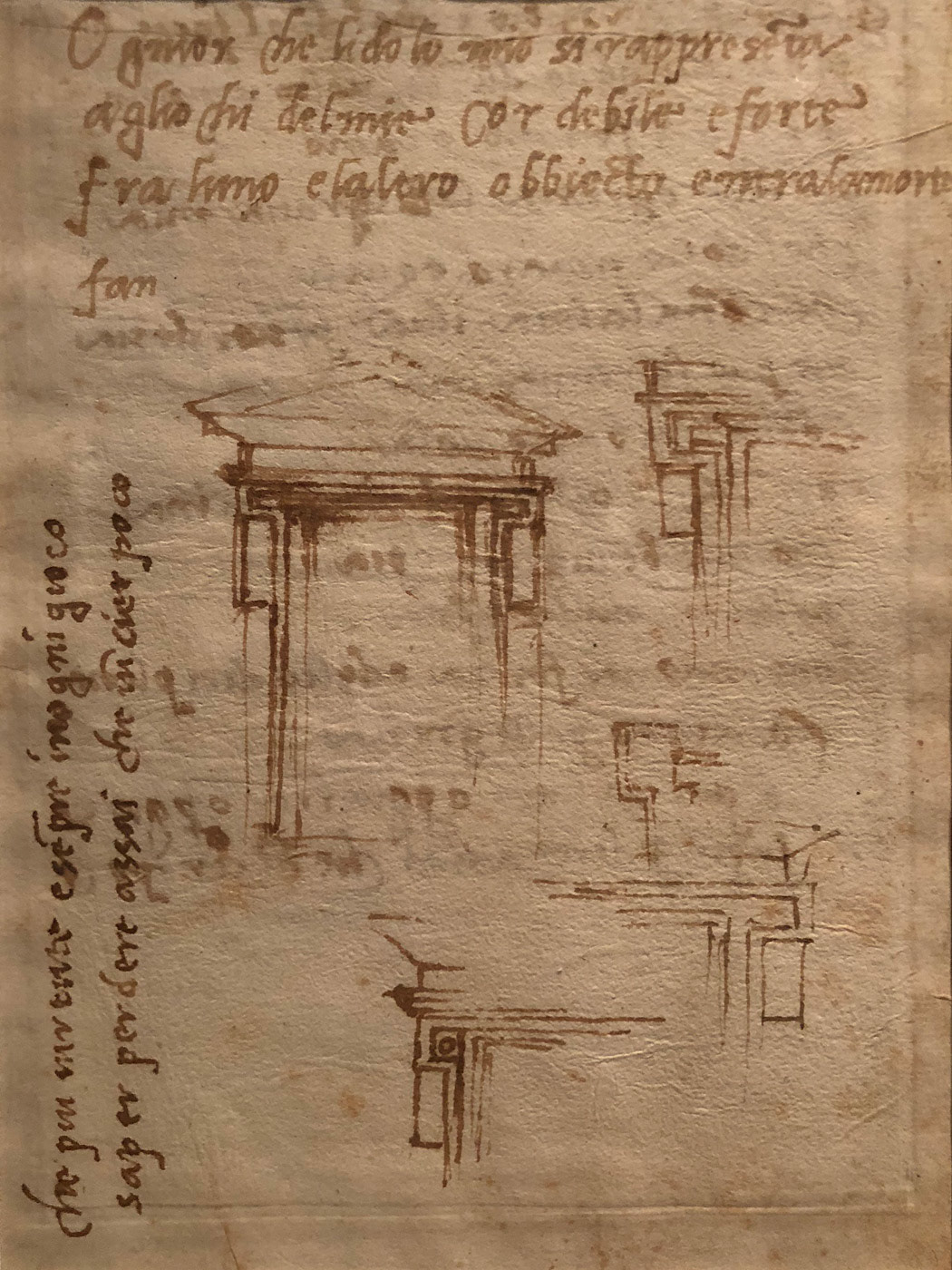

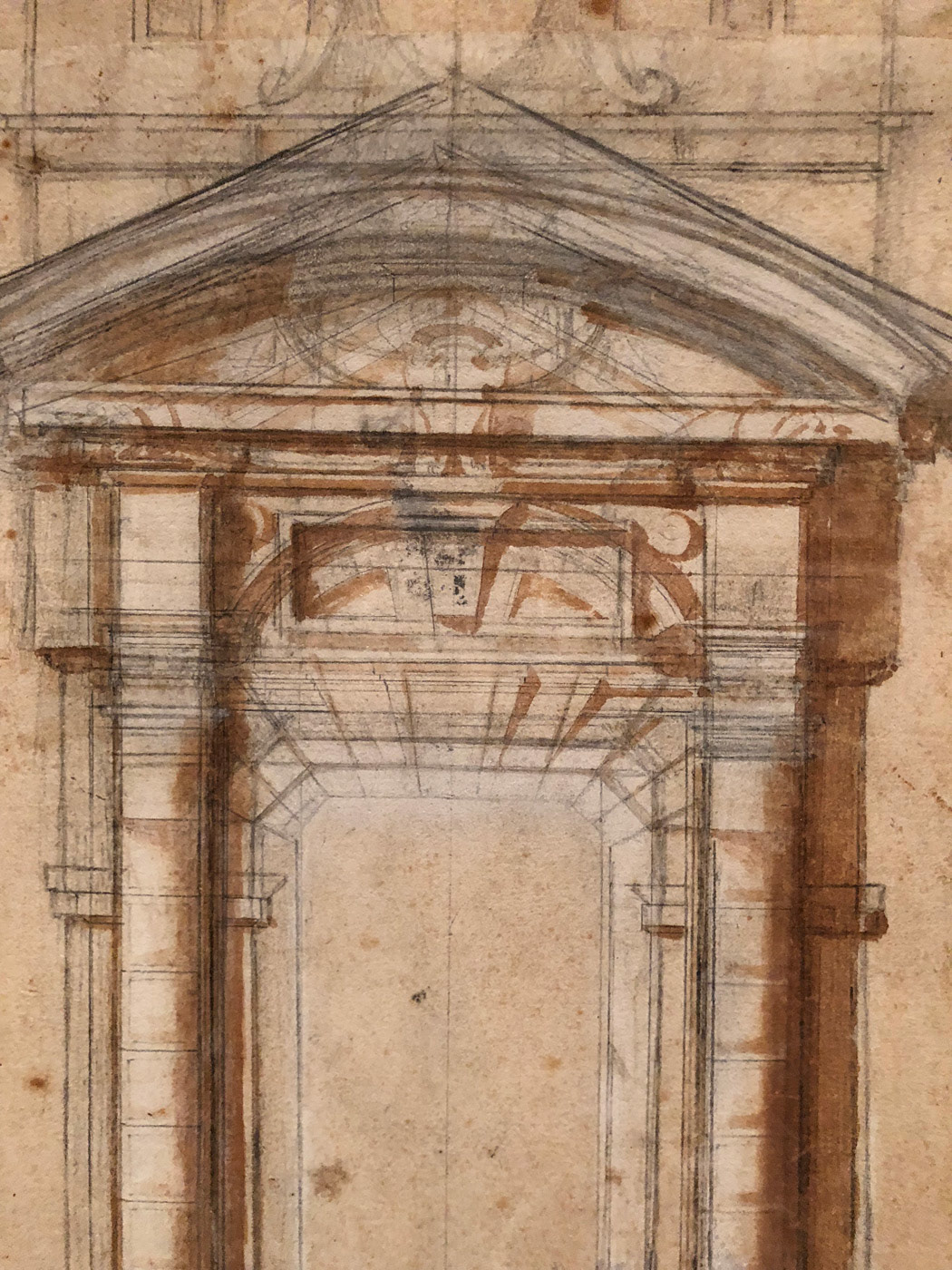
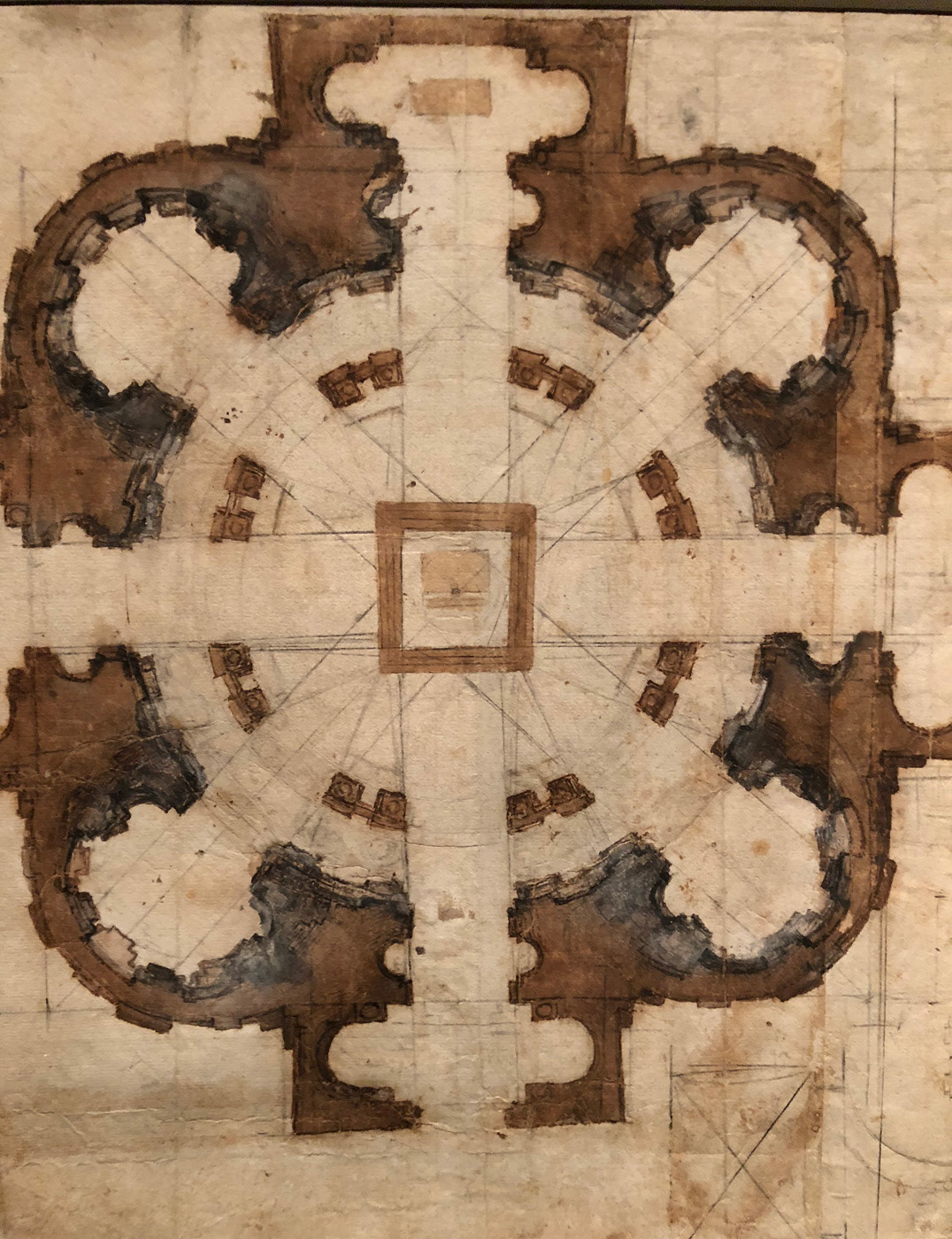
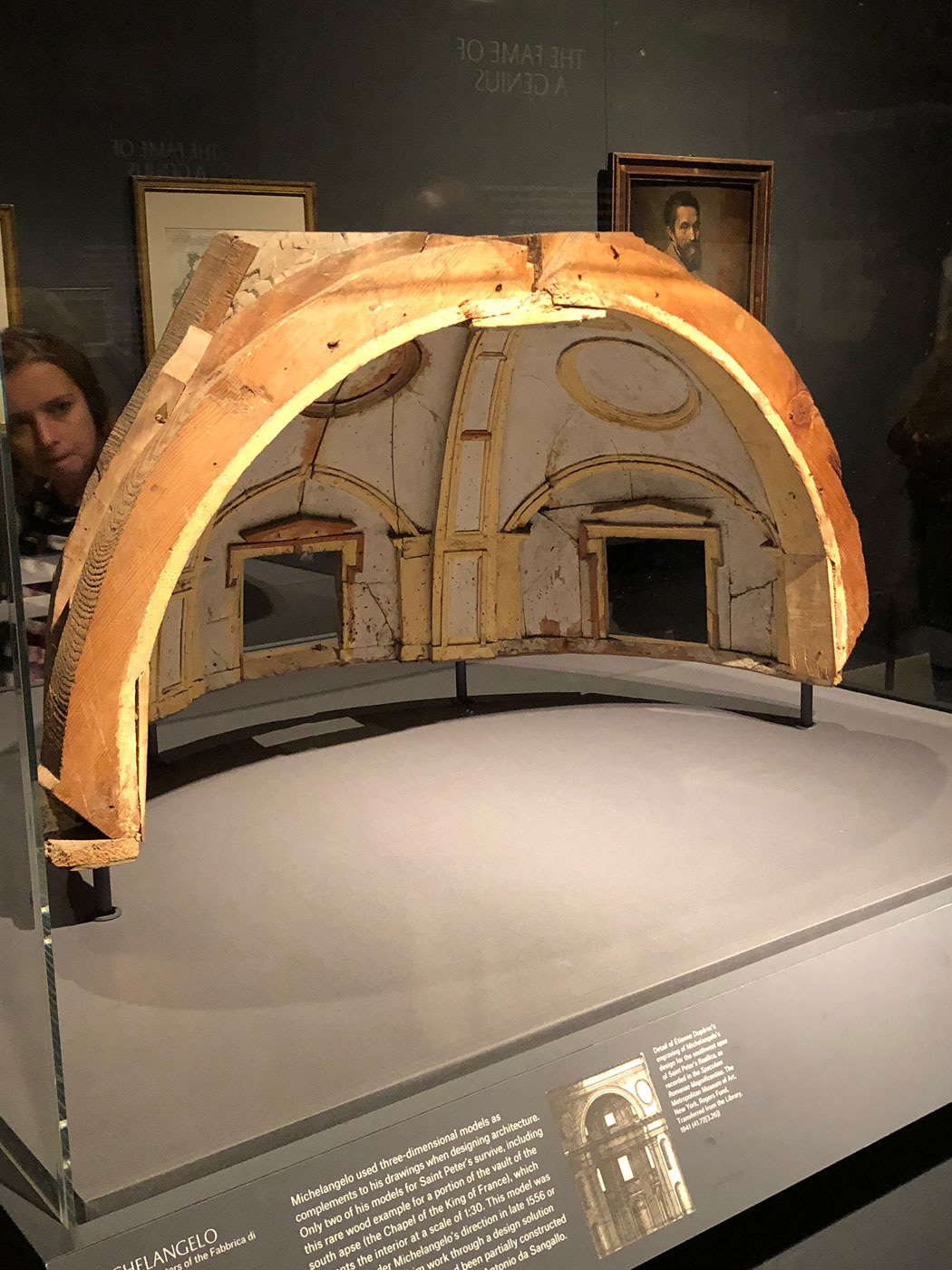
THE FAME OF A GENIUS
Portraits of Michelangelo, from the fanciful to the realistic, were produced and replicated in great numbers near the end of his life and after—a phenomenon only comparable to the treatment of nobles, rulers, and religious figures. He was pronounced dead on February 18,1564, two weeks shy of his eighty-ninth birthday, with dear friends at his side, including Tommaso de’ Cavalieri and Daniele da Volterra.
In lamenting Michelangelo’s death, the self-interested Duke Cosimo I de’ Medici also despaired that the artist had destroyed his own work: “Our vexation is only increased by the fact that he left no drawings, for it did not seem to us to be an action worthy of him to have surrendered the drawings to the fire.” Documents independently confirm that the artist had ordered his drawings burned on several previous occasions as well. Vasari’s 1568 biography attributes Michelangelo’s willful destruction of his numerous drawings, sketches, and cartoons to a wish “that no one might see the labors he endured and the methods with which he tested his imagination, so that he might appear nothing less than perfect.”
Portraits of Michelangelo, from the fanciful to the realistic, were produced and replicated in great numbers near the end of his life and after—a phenomenon only comparable to the treatment of nobles, rulers, and religious figures. He was pronounced dead on February 18,1564, two weeks shy of his eighty-ninth birthday, with dear friends at his side, including Tommaso de’ Cavalieri and Daniele da Volterra.
In lamenting Michelangelo’s death, the self-interested Duke Cosimo I de’ Medici also despaired that the artist had destroyed his own work: “Our vexation is only increased by the fact that he left no drawings, for it did not seem to us to be an action worthy of him to have surrendered the drawings to the fire.” Documents independently confirm that the artist had ordered his drawings burned on several previous occasions as well. Vasari’s 1568 biography attributes Michelangelo’s willful destruction of his numerous drawings, sketches, and cartoons to a wish “that no one might see the labors he endured and the methods with which he tested his imagination, so that he might appear nothing less than perfect.”


